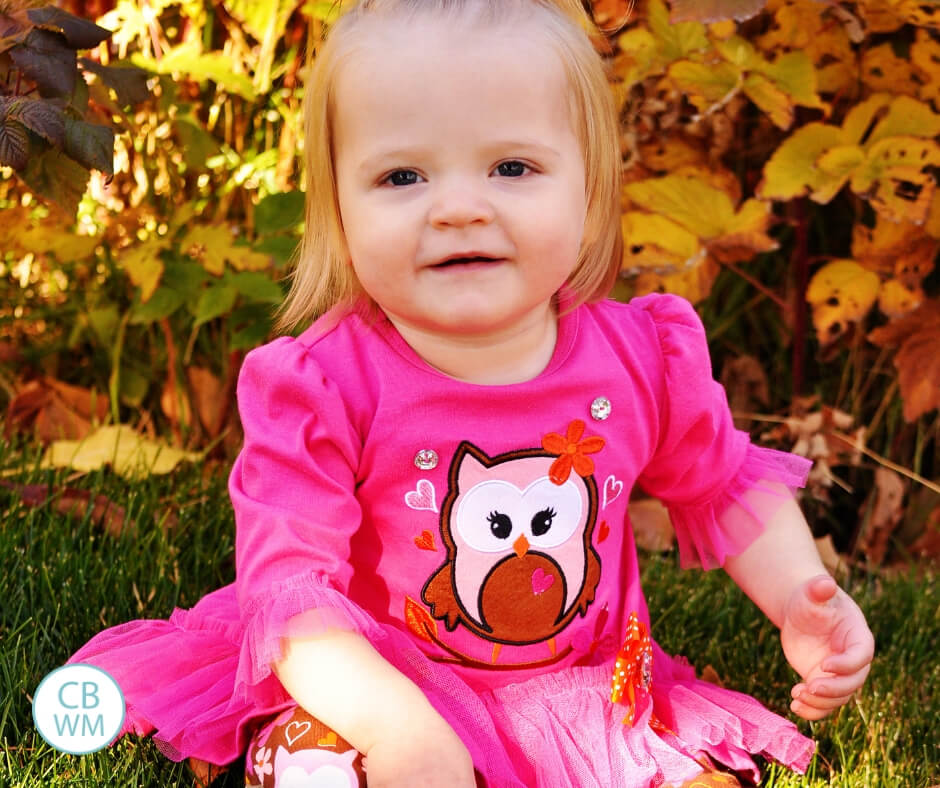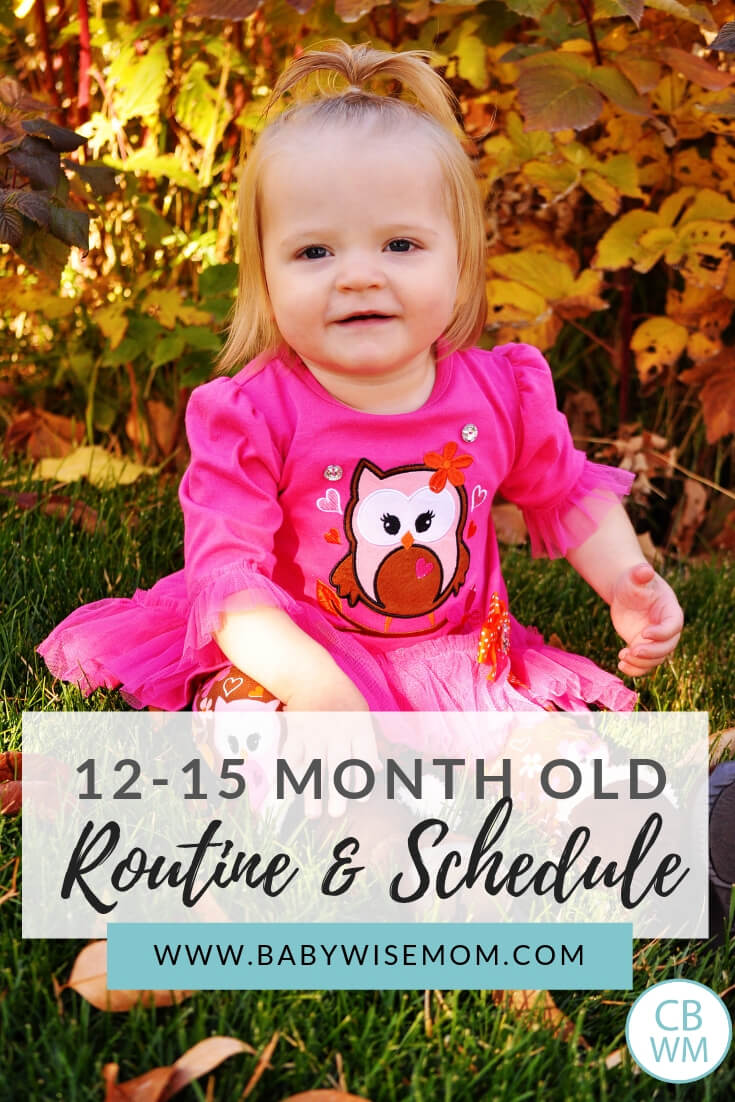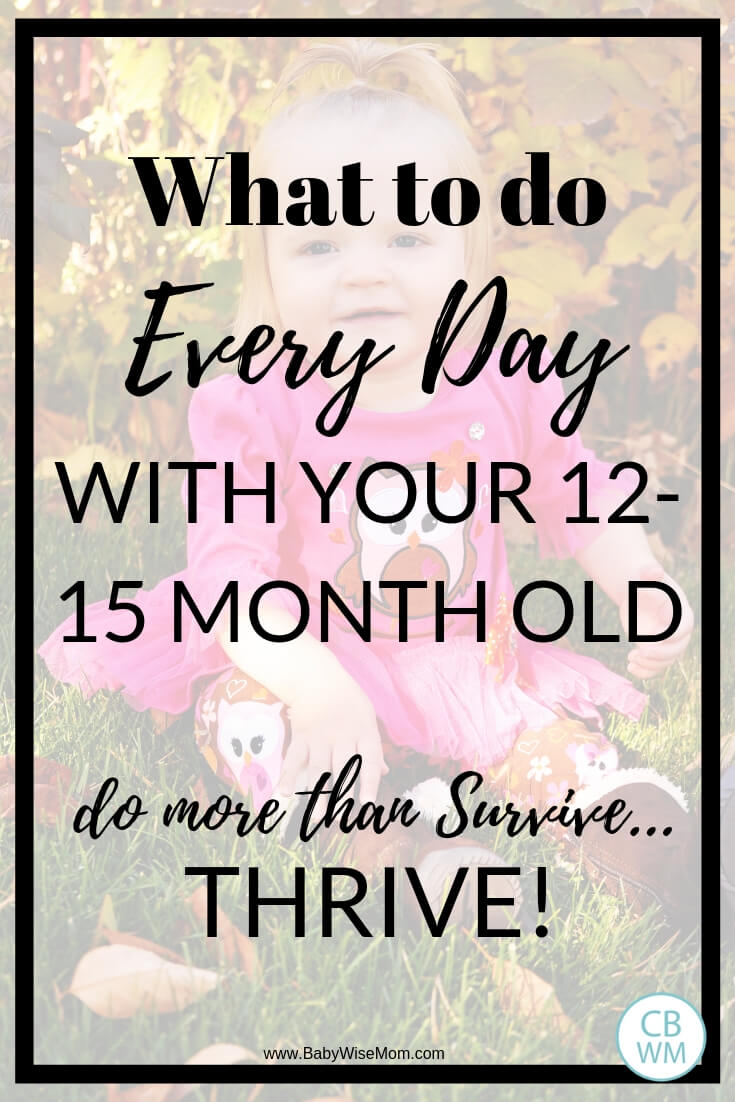Routine and schedule to do with young toddlers. Get ideas on how to structure your day and do more than just make it through each day.

If you have a 12-15 month old, your biggest concern in life right now is likely discipline. You also are experiencing big changes with appetite and perhaps even sleeping patterns in the day.
You are starting to see your “baby” as more of a toddler and coming to realize the many things you need to teach him, and that might be a bit overwhelming.
This is a time period you really want to be sure you, the parent, are in the habit of doing more than making it from sunrise to sunset without drama. Focus on discipline and focus on learning activities.
You want to set solid expectations now so your future is easier. As difficult as a 12-15 month old seems, there is a reason they call it “terrible twos” and “threenagers.” You can’t ignore things now and hope it will get easier.
Let’s discuss the day.
Post Contents
- MEALTIMES FOR PRETODDLERS
- NAPTIMES FOR PRETODDLERS
- INDEPENDENT PLAYTIME FOR PRETODDLERS
- FREE PLAYTIME FOR PRETODDLERS
- STRUCTURED PLAYTIME FOR PRETODDLERS
- SIBLING PLAYTIME
- ONE-ON-ONE TIME WITH PARENTS
- FRIEND TIME
- FAMILY TIME
- BATHTIME
- LANGUAGE DEVELOPMENT FOR PRETODDLERS
- TIME OUTSIDE
- ARTS FOR PRETODDLERS
- TOYS FOR PRETODDLERS
- OTHER INTERESTS
- LEARNING TIME FOR PRETODDLERS
- DISCIPLINE FOR PRETODDLERS
- OTHER GOALS for PRETODDLERS
- Conclusion
MEALTIMES FOR PRETODDLERS
You might suddenly find yourself as stressed about food as you were when your child was a newborn. Things are changing, and you aren’t quite sure what is normal and what isn’t. Here are some common concerns:
Drop in Appetite: This is an age range when most babies…er…pretoddlers will severely drop the amount of food they eat each day. Most babies triple their birth weight in the first year, while in the second year they only add about a third of their birthweight (What to Expect the First Year, page 489).
Always keep in a mind a child will not starve herself. Read up on Food Amounts for Toddlers for tips.
Keep in mind, your child was able to go 2.5-3 hours between meals as a newborn baby and that will not change now that she is a pretoddler. If she doesn’t eat at her meal, you don’t want to turn to grazing a bit every hour out of fear she is starving.
Stick to scheduled meals and snacks (unless your child is sick). Your child will eat at meal times.
Weaning From Bottle: If you haven’t weaned from the bottle yet, make it a goal to start during this period. This can be a process–you don’t have to just drop it all in one day. Weaning: Breast, Bottle, and Formula
Learning to Self-Feed: During this age range, most toddlers will start to want to feed themselves with a spoon. This will likely come closer to the end of this age range.
Once your child shows interest, allow him to try. Expect a mess. So long as the mess is from your child just not being good at using the spoon yet rather than purposely making a mess, there is nothing to worry about (other than the fact that you have a mess to clean up). When letting him practice, be intentional about what he practices with. Yogurt sticks to a spoon better than applesauce, for example. See Toddlers and Spoons
Seeming Regression: You will likely find your child wants to feed himself and gets started. Then he decides that he wants you to feed him. You might then worry that he is regressing and will never feed himself. You might picture yourself spoon feeding a 12 year old.
My son did this; I had that worry. Some children really want independence, but then want to be a little kid again. Rest assured that your child will get to the point of eating independently. This will not be the last time you see your child waffling between growing up and staying little (I call it Peter Pan Syndrome).
Aligning Meals: If meals are not already in sync with the family, now is the time period to do so. Breakfast and lunch are most likely in line.
Dinner is the harder one because most families eat dinner later than the child can make it. If so, offer a snack after the afternoon nap to hold baby over. You could even just do the liquid feeding at that point without any solid foods.
Be sure to monitor the snack by paying attention to your child’s appetite at dinner. If he isn’t eating like he should, the snack was likely too large.
Good Meals/Bad Meals: I have found that toddlers will often have a “bad” meal each day where they seem to eat nothing at all. They usually counter this with a “good” meal where they eat a lot. Transition yourself to looking at food intake as a whole each day rather than just each meal. It is normal for a toddler to have meals where he doesn’t eat much, even for a toddler.
Eating What Family Eats: During this time period, you will likely start to feed your child whatever the family is eating. There will obviously be some things he can’t eat because of safety (choking) or the food just isn’t appropriate for that age of a child yet. But other things can be given. Some toddlers will still stay on pureed baby food during this time period. See Solids: When Do You Stop Babyfood and Move to “Real” Food?
Dropping the 4th Feeding: Most toddlers will drop the fourth liquid feeding during this age range, though not all. Brayden kept it until 18 months. See Tips for Dropping the 4th Feeding
Bib Use: During this age range, Brayden was done with the bib. Your toddler is now watching everyone more closely and he will soon realize he is the only one eating with a bib. Kaitlyn continued her bib use through this stage, however.

NAPTIMES FOR PRETODDLERS
Sleep should be of little worry during this stage. There are a couple of things that can come up:
- Dropping the Morning Nap: Some babies are ready to drop the morning nap as early as 14 months. But be aware that most will be closer to 18 months. If you start having napping trouble, see this post: Dropping the Morning Nap (from 2 to 1 naps): Transition Time
- You Slack on Consistency: As your baby becomes a toddler, you might start to slack on the consistency of meals and naps. You might start offering too many snacks or staying out during naptime. Be aware that eating patterns affect sleeping patterns and sleeping patterns affect eating patterns. This is not a time to stop concerning yourself with consistent naps. Your toddler might be able to miss one every so often, but don’t make it a habit.
Waketime Length. Your toddler’s waketimes continue to increase. Add to that mobility and curiosity and you have lots of time to fill and lots of discipline issues that crop up.
Read up on Optimal Waketime Length for Toddlers here.
INDEPENDENT PLAYTIME FOR PRETODDLERS
For most toddlers in this age range, independent playtime will continue in the playpen. At some point, you might transition to roomtime. See:
FREE PLAYTIME FOR PRETODDLERS
Free playtime starts to change during this age range. You allow your child to choose the activity he plays with. That is why it is “free.” He doesn’t get to jump from activity to activity; you want him to learn to have a sustained attention span. But he can have more than one toy available to him during this time. Free playtime can really be any activity the child chooses. Your toddler still needs to be supervised during this playtime.
Read: How to Use Free Playtime in Your Child’s Schedule
STRUCTURED PLAYTIME FOR PRETODDLERS
Up to this point, structured playtime has been independent playtime. Now you add another element to your day. Structured playtime is when Mom decides the activity. This is a good thing for your toddler to learn to accept; in educational settings (and life), we don’t always get to choose what we do. This time can be art, music, puzzles, or other learning activities. The child can work alone or with a parent or sibling (see below).
Read all about How to Do a Preschool Homeschool here.
SIBLING PLAYTIME
If your toddler has siblings, you can have sibling playtime. This can overlap with other activities if needed. For example, the siblings can both color at the table together. Or maybe they will go outside to play together for outside time.
During this age range for Kaitlyn, I started to allow Brayden and Kaitlyn to be alone for longer increments, though still not very long. I always monitored them, also, after an interesting experience.
One time, they were playing in the sandbox together. Kaitlyn was about 12 or 13 months old, which put Brayden just under or at three years old. I ran inside to get something to work on the garden (which is right by to the sandbox). I was not gone for more than a few minutes.
When I came back, I found Brayden had kindly turned on the hose and washed Kaitlyn’s lower body off since it was sandy. This was a moment of childishness for him; he did not know there was anything wrong with it. She didn’t object in the least.
I realized I needed to instruct more before leaving them alone outside together. I also needed to observe more before being out of eyesight so I could grasp the things Brayden might do. I never imagined he would use the hose on her. I actually didn’t know he was capable of turning it on himself. It was really quite funny, but not something I let Brayden see I found amusing.
ONE-ON-ONE TIME WITH PARENTS
Continue to be sure to incorporate one-on-one time with each parent each day. This can overlap with structured playtime. Mommy or Daddy can sit at the table with the toddler while he colors and join in the coloring. It can also overlap with your bedtime routine as someone reads him a bedtime story at night.
FRIEND TIME
The older your toddler gets, the more he will enjoy playing with friends. At this age, play is still very much in tandem; they don’t really interactively play with each other. But being in each other’s presence is fun.
FAMILY TIME
It is fun to do activities together as a family. You might go for walks, read books, work in the yard, go out to dinner…the possibilities are endless.
BATHTIME
Bath time can be a fun time to get water play in. It is a good opportunity for your child to fulfill that curiosity with water. What happens when I dump a cup of water out? Your child can figure that out in the tub. Bath time has always been a big playtime at our house, and it has been a favorite part of our day. Read up on our Best Toys for Baby: Bath Toys
LANGUAGE DEVELOPMENT FOR PRETODDLERS
Continue to work on language development for this age group. Her are some things that will help.
Sign Language: It isn’t too late to start this. I started Brayden during this age range. Watch for words that would help your child avoid tantrums. If you have been doing this for a while, you can most likely do a new word each day, or at least several per week. Read How To Teach Your Baby Sign Language
Reading: Reading is a fun activity to have as one-on-one time with a parent. Be sure to point to the objects in the book and name them for your toddler. Read up on The Value of Reading Aloud to Your Children
Talk Back: When your child talks to you, listen and talk back. Keep in mind the principles from the previous making it through the day post for ages 9-12 months old. Have conversations with your child.
TIME OUTSIDE
You can continue the activities you have been doing outside (walks, hikes, etc.). Here are some other ideas:
- Sandbox: The sandbox is a fun place to play.
- Mimic: Toddlers love to mimic their parents. If you garden, you might get some gardening toys for your toddler. If you have a lawn to mow, a lawnmower.
- Bubbles: This is always fascinating for the toddler.
- Outside Toys: See this post for outside toy ideas: Outdoor Toys Children Will Love
ARTS FOR PRETODDLERS
You can add some time for the arts. You might dance, sing, and/or draw. It is wonderful to pass on your passion to your children, but also be sure you expose them to arts that aren’t necessarily your interest.
For example, I love to sing and I love to dance. It is quite natural for me to expose my children to these items. I am not an artist when it comes to drawing, painting, etc. These are activities I have to make a conscious effort to add to our day because it isn’t a natural interest of mine. Here are our favorite art supplies.
TOYS FOR PRETODDLERS
Your child’s interest will continue to mature as he gets older. See this post: Best Toys for Baby: 12-18 Months
OTHER INTERESTS
Your toddler will start to show interest in certain subjects. Is it trucks? Perhaps a car show would be of interest. Maybe he is interested in animals? The zoo might be a fun trip. Look around your area for age and interest-appropriate museums to visit.
LEARNING TIME FOR PRETODDLERS
You might be especially interested in learning activities now. See these posts:
- Factors that Influence Learning
- The Learning Process (Toddlerwise)
- Critical Phase of Learning: Toddlerwise
DISCIPLINE FOR PRETODDLERS
There are a lot of discipline concerns during the toddler years. Here are posts pertinent to this age group:
- Proactive and Directive Parenting
- How To Give Your Toddler Boundaries
- How To Teach a Child How to Make Decisions
- Controlling the Young Temper
- Encouragement as a Discipline Tool
- Get To Know Your Child’s Personality
- Hand Folding: Establishing Self-Control
- The “Mini-fit”
- Why Prevention is a Powerful Teaching Tool
- Problem Solving Using Beliefs, Goals, Why, and How
- Substitution: Toddlerwise
- Tips for Avoiding and Responding to Tantrums
- Tantrums: Stop and Think
- The Choice Addiction (for Toddlers)
- Training in Times of Non-Conflict
- “Yes Mom”
OTHER GOALS for PRETODDLERS
- Toddlerwise: On Becoming Toddlerwise is written for ages 1-2 years old. Be sure to read it. On Becoming Toddlerwise
- PreToddlerwise: On Becoming PreToddlerwise is written for 12-18 months old, so you will find helpful information for this exact age group.
- Why vs. How: PLEASE be sure to read this post: Why vs. How
- Will Toys in Bed Disrupt Sleep
- Creating a “Good Helper”
- Beliefs and Goals (Toddlerwise)
- Overstimulation for Toddlers
- Change Your Strategy
- Parenting Skills: Look to Yourself First
- Sample Schedules: One Year and Up
- Dentist: I don’t know when you will take your toddler to the dentist. I start at one year, so here are my Dentist Tips
Conclusion
You can do more than just make it through each day with your young toddler. A few goals will help you be intentional about your day and set up your upcoming toddler years for success.
Find my other More Than Making it Through the Day Posts here.

